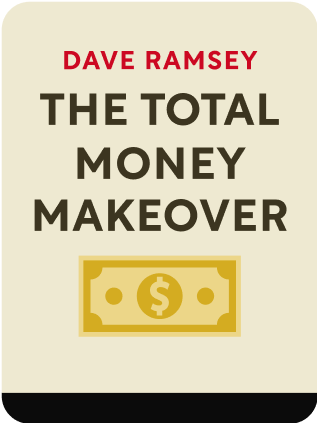

This article is an excerpt from the Shortform book guide to "The Total Money Makeover" by Dave Ramsey. Shortform has the world's best summaries and analyses of books you should be reading.
Like this article? Sign up for a free trial here .
What is the Total Money Makeover by Dave Ramsey? How can the Total Money Makeover revolutionize your life?
The Total Money Makeover is a program and a book by Dave Ramsey. You can set yourself up for financial peace of mind.
Read more about the Total Money Makeover by Dave Ramsey.
Total Money Makeover by Dave Ramsey
How you handle your finances determines whether you succeed in life. In the Total Money Makeover book, radio talk show host and author Dave Ramsey lays out simple steps for freeing yourself from debt and setting yourself up for success: following a monthly budget, buying only what you can afford, eliminating consumer debt, saving for emergencies, investing for retirement and your kids’ college education, and paying off your mortgage. Intended for everyone—from high earners to people thousands of dollars in debt—Ramsey’s common-sense principles put you in control of your money and your life.
Summary of the Total Money Makeover Book
To understand why you have money problems—why you’re heavily in debt and can never seem to make ends meet or handle emergencies—look in the mirror. Your financial situation is the result of your behavior, according to radio talk show host and author Dave Ramsey.
In the Total Money Makeover book, Ramsey lays out a program for freeing yourself from debt and money worries by changing your behavior: following a monthly budget, buying only what you can afford, eliminating debt, saving for emergencies, and investing. The program is intended for everyone—from high earners to people thousands of dollars in debt.
The Total Money Makeover motto is: live differently from everyone else in the present so you can live differently from everyone else in the future. This means that to live a better life than most people, you need to do what most people won’t do—make sacrifices now in return for the payoff of financial security later.
The fix for your financial situation isn’t a bigger salary, a windfall, or a better job, but acknowledging that your poor financial decisions are your fault and changing your behavior. This book lays out what you need to do, but only you can do it.
Myths About Debt and Money
People who get into financial trouble do so in part because they believe a host of societal myths about debt and money that encourage taking on debt and spending foolishly in order to buy things they can’t afford.
One of the biggest myths is that debt is normal. Debt has become so ingrained in our culture that most people can’t imagine living without it. We don’t know how to get a car, buy a home, or go to college without debt, and most people can’t imagine living without a credit card. Further, financial institutions, stores, and other lenders aggressively push you to borrow because they benefit when you owe them money.
You must reject the view that debt is normal before you can get control of your finances. The central tenet of the Total Money Makeover program is living debt-free and buying only what you can afford (what you can pay for immediately).
The belief that debt is normal and a way to improve your life promotes these myths:
- You need credit cards: People are often advised, particularly when they’re young, to get a credit card to build their credit. But you only need to build credit by borrowing and making loan payments if you want to spend your life making loan payments. In a Total Money Makeover, you won’t use credit, except possibly to pay a mortgage.
- A car payment is normal: Car payments are both foolish and avoidable. They’re most people’s biggest monthly outlay except for a mortgage, so they diminish or steal more from your income than any other expense. Over a lifetime of car payments, you’ll literally spend a fortune. Most people start making payments on one car, then continue car payments on successive cars throughout their lives.
- When you don’t have the money, get a quick fix: People who want quick money often turn to payday loans, rent-to-own deals, or “tote the note” car lots—but these are predatory lending schemes intended to exploit low-income people. Other bad ideas are credit repair schemes, debt consolidation, and bankruptcy. They’ll make your financial problems worse.
- You need a 30-year, fixed-term mortgage to buy a house: This type of loan is costly and consigns you to being in debt for much of your life. Better ways are saving your money and paying cash, or getting a 15-year, fixed-term mortgage and paying it off early as part of a Total Money Makeover.
Your Total Money Makeover requires first changing your view of debt, and then getting and staying out of debt.
Two Preliminary Steps
The Total Money Makeover process comprises seven simple steps, referred to in the book as baby steps. No matter how big your financial challenges, you can overcome them by taking each step, one at a time.
It’s important to follow the steps in the prescribed order, because they build on each other, like prerequisites for taking college courses. If you jump ahead to later steps, you’ll fail at them because you haven’t laid the foundation. Just concentrate on one step at a time in sequence. But before you start the sequence, there are two preparatory steps.
Preliminary Step #1: Make a Budget
Create a written budget each month determining where your money will go; if you don’t, it will just disappear without your thinking about it.
Here are the basic steps for creating a budget:
- Each month, draw up a budget for the next month. If you’re married, sit down with your spouse to do this.
- List next month’s bills, savings, and debts, then list and allocate every dollar of your income (think of this as spending the money on paper before the month starts). This process is referred to as zero-based budgeting: monthly income minus expenses equals zero.
- Once both partners agree on a budget, pledge not to do anything with your money that isn’t prescribed by the written plan. You can’t get control of your spending without working together. If something unexpected comes up—for instance, your car needs repairs—hold an emergency meeting and together reallocate and balance the categories so that the month’s income minus expenses still equals zero.
Preliminary Step #2: Catch Up on Loan Payments
Besides creating a monthly budget, get current on all loan and credit card payments. If you’re behind on any payment, you need to catch up. If you’re really behind, pay for your necessities first—food, shelter, and transportation—then catch up on monthly loan payments. You can’t start a Total Money Makeover, which hinges on eliminating debt, until you’re keeping up with your payments.

———End of Preview———
Like what you just read? Read the rest of the world's best book summary and analysis of Dave Ramsey's "The Total Money Makeover" at Shortform .
Here's what you'll find in our full The Total Money Makeover summary :
- The 7 steps to achieving financial stability (you'll love #7)
- A fool-proof plan for becoming debt-free
- How myths about debt and money are crippling your financial health






